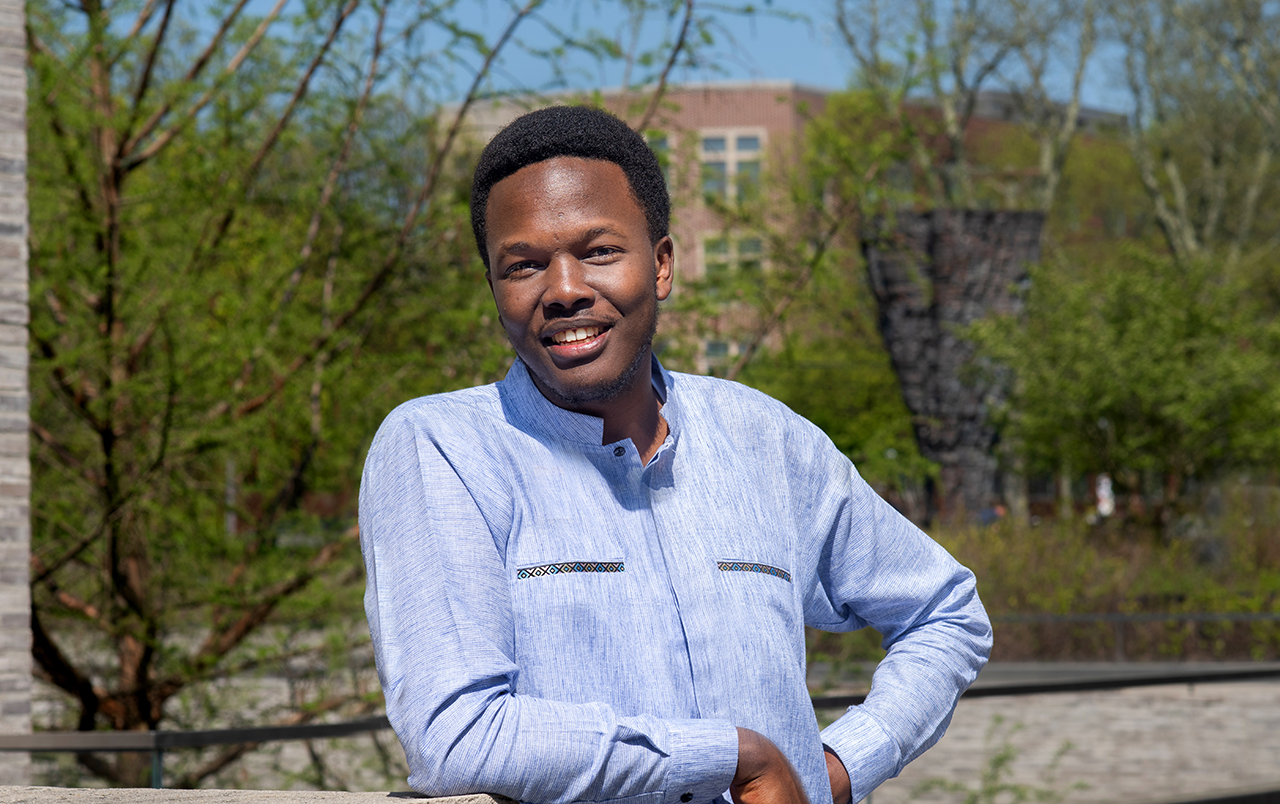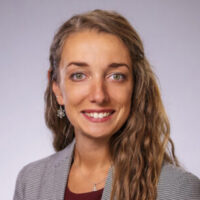
Darius Rudasingwa Ganza: Exploring new materials for carbon capture
By Colton Poore
Inquisitive by nature, Darius Rudasingwa Ganza, a rising senior studying chemical and biological engineering, has always been curious about the possibility of engineering new materials that could change the way the world works. “I’m always thinking to myself, ‘let me see what this or that idea is all about,’” he said.
His curiosity led him to an internship after his sophomore year through the Andlinger Center for Energy and the Environment, working with Michele Sarazen, assistant professor of chemical and biological engineering, to investigate the properties and stabilities of novel materials for capturing carbon dioxide (CO2).
“The idea that you could make a material that was able to capture carbon dioxide, that was mind-blowing to me,” Ganza said.
Working closely with Rachel Yang, a graduate student mentor, Ganza and other researchers studied the properties of materials formed from a CO2-capturing polymer known as poly(propylene imine), or PPI, supported within a metal-organic framework, a type of porous solid that can stabilize CO2-adsorbing polymers. Such composite materials, made up of an adsorbent and a metal-organic framework, could play an important role in both direct-air carbon capture and the capture of carbon in flue gas from power plants.

A critical feature of any industrial carbon capture material is its ability to remain effective under varying environmental conditions. As such, the researchers were especially interested in how PPI performed after being stored in different environments, particularly in comparison to poly(ethylenimine), or PEI, a commercially available adsorbent that has known stability limitations. When supported within a metal-organic framework, PEI degrades when exposed to ambient air, leading to lower CO2 storage capacities in a matter of days. This poor shelf-stability of PEI is a limiting factor in its widespread industrial application.
“PEI is commonly explored for its potential applications to industry, but its performance decreases considerably over time,” Ganza explained. “We were looking into ways to make a more stable material that could be used and reused for a lot longer than PEI.”
Ganza played an active role in the research. He synthesized experimental materials, which required combining different amounts of the polymers PEI and PPI with UiO-67(Zr), a type of metal-organic framework. Ganza also helped measure how well each material captured carbon after being stored in various solvents and environments. And after studying the materials’ performance, he helped characterize the materials’ structure after use to understand how they had changed over the course of the experiments.
“It was exciting to be able to make something with a specific function in the world,” Ganza said. “A lot of times, the classes we take as students are fairly theoretical, but on this project, I was actually making materials that I could see working in real-time.”
Ganza’s summer culminated with a peer-reviewed research paper. He is the second author on a paper published Jan. 2023 in Materials Advances, which details the work that he and the rest of the research team did to understand the shelf-stability of composite materials for carbon capture. The team found that overall, PPI was more stable than PEI in air and several other storage mediums. But the researchers noted tradeoffs in stability, CO2 storage capacity, and adsorption speed between the tested materials.
“Darius was a valuable addition to the research team,” said Sarazen, who is also an associated faculty at the Andlinger Center. “His work to prepare and test the materials was critical to informing subsequent studies completed in the group, and it was exciting to see him develop his research skills over the course of the summer. Beyond this project, he will continue working with our lab for his upcoming senior thesis project to continue addressing sustainability and climate solutions and growing his skills as a researcher.”
While he continues to explore various career paths, Ganza said his summer internship with the Sarazen lab showed him the powerful impact that materials research can have on the world. He said he hopes to use the skills and training he has gained as an engineer at Princeton to one day return to his home in Kigali, Rwanda to conduct impactful academic research or work to develop industry.
“It was an incredible opportunity to be involved as an undergraduate in the same thing that I had thought was only for postdocs and graduate students,” Ganza said. “It really helped to train me as a potential future researcher, and it opened my eyes to a lot of the possibilities of doing research.”
The paper, “Investigation of storage environments on aminopolymer stabilization within UiO-67(Zr) for CO2 capture,” was published Jan. 2023 in Materials Advances, with Rachel Yang as first author. In addition to Yang, Ganza, and Sarazen, authors include graduate student Michael Smith and undergraduate senior Stanley Cho of Princeton University, as well as Jacqueline Vandermel and Elizabeth Jiang, two high school students who worked with the Sarazen lab through the Laboratory Learning Program.
Darius Rudasingwa Ganza’s internship with the Andlinger Center was supported by the Peter B. Lewis Fund for Student Innovation in Energy and the Environment.
Featured summer interns:
- Anherutowa Calvo: Building a toolbox of skills, in energy and bioengineering
- Arielle Rivera: Lighting Puerto Rico’s energy future
- From bird watching to code writing, Riti Bhandarkar reflects on her path to energy
- From boreholes to home energy audits, Andlinger Center summer interns discover breadth of energy jobs